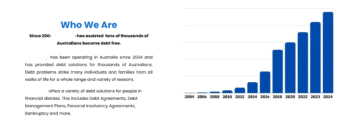I first noticed something was wrong when financial services and accounting businesses used stock photos and service-based headlines instead of leading with their own images and ethos.
The authenticity gap was something I could feel, but the real damage was hidden in the words themselves.
The Sentence Overload Problem
When I work with financial planners in Moreton Bay on their copy or content, I see the same mistake repeatedly. They stuff all their reasons to see an adviser into one sentence.
It’s too much information to take in.
They also don’t use intriguing stories or personality to underline their point. The copy could belong to any financial planner. There’s no person-to-person connection.
Here’s what changes when you get it right.
Show Don’t Tell
Instead of writing “we invest a lot of time to understand your personal situation, which enables us to tailor advice to you”, tell a story.
An example: A picture frame maker came to a financial planner wanting advice on how to make their dream of semi-retiring and hiring other frame-makers come to bear. Then you say your advice was based on that specific end goal.
When that story runs instead of the generic statement, it’s more effective. Other artistic or craft people who can’t see a clear path to their goals stay longer on the page. They engage. They see themselves in that story.
There’s neurological proof behind this. Stanford research shows that story retention hits 63% whilst statistics barely reach 5%. Stories bypass our critical analysis and speak directly to our humanity.
The “We Are” Battle
I know you’re keen to get the experience and authority in there… but don’t start your website home page from your perspective. Put it in the About page or section lower down.
“You” or “Your” should be the first word on the page.

The “I Don’t Get It” Moment
When a mechanic or local shop owner encounters terms like “strategic alignment” or “value proposition”, they’re thinking one thing.
I don’t get it.
Most people haven’t done a business or marketing course. They like people. They run their business. But jargon confusion pushes them away quickly.
Tradies might self-judge more than others when reading business content. But we all love stories — story has intrigued us since we all sat around campfires.
The Revision Room Battle
During my copywriting days from 2009 to 2014, I watched medium-sized businesses fight to add corporate language back into their copy. They’d insist on putting “dynamic” or “synergy” in during revisions.
They thought plain English sounded too basic. Research proves the opposite. Corporate jargon actually destroys trust rather than building it. Abstract language makes people doubt you’re telling the truth.
Bob Bly said it perfectly:
“The words in your copy should be like the windows in a storefront. The reader should be able to see right through them and see the product.”
Simplicity Equals Credibility
When someone pushes back on plain English, I point them to Morgan Stanley.
One of the largest financial advisors in the world uses simple, easy-to-read headings and explanations. They’ve proven that simplicity equals credibility.
The Channel Trap
The most time gets lost trying to win an advisory game with a blunt tool like Instagram.
Pick a channel where your words are seen and where people can genuinely connect to you as a professional. Blog. LinkedIn. Columnist positions.
These platforms let your message breathe and your expertise show through clear communication.
If your content isn’t working, the problem likely sits in one of these areas: Overloaded sentences. Generic statements instead of specific stories. Jargon that pushes away the very people you’re trying to reach. Or the wrong channel entirely.
Plain English is powerful. It’s specificity and authentic stories that will bring it to life.
If you’re ready to discover a content strategy that actually connects with your ideal clients, let’s chat. Book a free video call and we’ll map out an approach that works for you.


